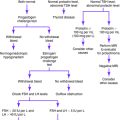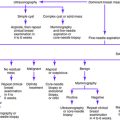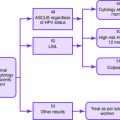Chapter 24 NAUSEA AND VOMITING DURING PREGNANCY
Nausea and vomiting of pregnancy, also known as morning sickness, is very common, affecting 70% to 85% of pregnant women. It can range in severity from mild nausea to hyperemesis gravidarum. The cause of nausea and vomiting of pregnancy is not known. Risk factors include molar gestation, multiple gestation, family history, or a history of hyperemesis gravidarum in prior pregnancies. Recognition and treatment of milder symptoms can prevent progression of symptoms and hospitalization.
Key Historical Features
✓ History of nausea and vomiting with other pregnancies
✓ Significant weight loss associated with vomiting
✓ Fever and chills, which may indicate infection such as cholecystitis, pyelonephritis, or appendicitis
✓ Palpitations, heat intolerance, or anxiety, which may indicate hyperthyroidism
✓ Medical history, especially history of thyroid disease, liver disease, gallbladder disease, pancreatitis, gastroesophageal reflux disease, migraines, or diabetes
✓ Review of systems, especially the following:
Key Physical Findings
✓ General assessment of health and well-being
✓ Neurologic examination to evaluate for a central nervous system disorder
✓ Cardiovascular examination for tachycardia, which may indicate dehydration, infection, or hyperthyroidism
✓ Gastrointestinal examination
✓ Back examination for costovertebral angle tenderness, which is suggestive of pyelonephritis
✓ Extremity examination for edema, suggestive of preeclampsia
Suggested Work-Up
| Pregnancy test | To confirm pregnancy if not already done |
| Urinalysis | For ketonuria and a high specific gravity, which indicate dehydration |
| For pyuria, which indicates possible urinary tract infection | |
| For glucosuria, which indicates hyperglycemia and possible diabetes | |
| For proteinuria, which may indicate preeclampsia |
Additional Work-Up
| Serum glucose measurement | If diabetes mellitus is suspected |
| Complete blood cell count | To evaluate for infection such as cholecystitis or pyelonephritis |
| Blood urea nitrogen (BUN) and creatinine measurement | To evaluate for dehydration or renal disease |
| Serum electrolyte measurements | For hypokalemia or hyponatremia in cases of severe vomiting |
| To evaluate for the development of acidosis in patients with severe dehydration | |
| Liver enzyme measurements | If hepatitis is suspected |
| Bilirubin measurement | If gallbladder or liver disease is suspected |
| Amylase or lipase measurement | If pancreatitis is suspected |
| Thyroid-stimulating hormone (TSH) | If thyroid disease is suspected |
| Abdominal ultrasonography | If liver, gallbladder, or pancreatic disease is suspected |
| Obstetric ultrasonography | If multiple fetuses or molar disease is suspected |
| Esophagogastroduodenoscopy | If peptic ulcer disease is suspected |
American College of Obstetrics and Gynecology. ACOG (American College of Obstetrics and Gynecology) Practice Bulletin: nausea and vomiting of pregnancy. Obstet Gynecol. 2004;103:803-814.
Goodwin TM. Hyperemesis gravidarum. Clin Obstet Gynecol. 1998;41:597-605.
Koch KL, Frissora CL. Nausea and vomiting during pregnancy. Gastroenterol Clin. 2003;32:201-234.
Kuşcu NK, Koyuncu F. Hyperemesis gravidarum: current concepts and management. Postgrad Med J. 2002;78(916):76-79.
Quinlan JD, Hill DA. Nausea and vomiting of pregnancy. Am Fam Physician. 2003;68:121-128.





